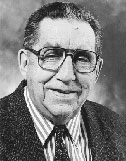Willard Munger
Willard Munger | |
|---|---|
 | |
| Member of the Minnesota House of Representatives from the 59, 59B, 7A district | |
| In office 1955-1965 | |
| In office 1967-1999 | |
| Personal details | |
| Born | January 20, 1911 Business owner, legislator |
Willard Marcus Munger Sr.[1] (January 20, 1911 – July 11, 1999) was a Minnesota politician and a member of the Minnesota House of Representatives from northeastern Minnesota. First elected in 1954, he was re-elected to four more terms before running for the Minnesota Senate in 1964. Unsuccessful in that bid, he ran for the House again in 1966, and was re-elected every two years until his death in 1999. He holds the record as the longest-serving member of the House at over 42 years and seven months.[2]
Early years and political interest
Munger was born in
Before serving in the legislature, Munger worked with the marketing division of the Minnesota Department of Agriculture, and with grain inspection for the Minnesota Railroad and Warehouse Commission.[2] He was unsuccessful in his first bid for office in 1934 when he ran for the state House on the Farmer-Laborer party ticket. Later, he was active in the establishment and development of the Lake Superior Zoo.[3]
Legislative and environmental leadership
As a
Over time, Munger came to be known as Minnesota's "Mr. Environment."
Besides chairing the House Environment and Natural Resources Committee, Munger also chaired the Penal Institutions Committee during the 1959-1960 legislative biennium, and the Elections Committee during the 1961-1962 biennium. Through the years, he was a member of the Appropriations, the Capital Investment, the Energy and Utilities, the General Legislation, Veterans Affairs and Elections, the Metropolitan and Urban Affairs, the Rules and Legislative Administration, and the Ways and Means committees, and of various committee incarnations and subcommittees relevant to each.[2]
Death and legacy
Munger died of liver cancer on July 11, 1999. At the time of his death, he was also the oldest legislator in Minnesota history.[7] The Willard Munger State Trail is named in his honor the Willard Munger Inn was founded by him in 1954 and is now run by his grandson, Jeff. A 2009 book, "Mr. Environment: the Willard Munger Story," details his life and legacy.[8]
References
- ^ https://www.findagrave.com/memorial/6926238/willard-marcus-munger
- ^ a b c d e "Minnesota Legislators Past & Present - Legislator Record - Munger, Sr., Willard M". Leg.state.mn.us. Retrieved 2010-07-20.
- ^ a b "MPR: Willard Munger Obituary". News.minnesota.publicradio.org. 1999-07-12. Retrieved 2010-07-20.
- ^ "Munger returns in "Mr. Environment" - Star Tribune 3/3/2009 Retrieved 2010-07-20.
- ^ "willard munger/EARTH STEWARD/page two". Willardmunger.org. Retrieved 2010-07-20.
- ^ "Pioneer in environmental legislation turns 87 years old" (PDF). Retrieved 2023-10-13.
- ^ Oakes, Larry (1999-07-11). "Obituaries: State Rep. Willard Munger". StarTribune.com. Retrieved 2010-07-20.
- ^ "Mr. Environment" Retrieved 2010-10-15.
External links
- Willard Munger at Minnesota Legislators Past & Present
- "Pioneer in environmental legislation turns 87 years old" - Session Weekly 1/23/1998
- Willard Munger Obituary - Minneapolis Star-Tribune 7/11/1999
- Remembering Willard Munger - Minnesota Public Radio 7/12/1999
- "Mr. Environment: the Willard Munger Story" - 2009 Book Summary and Reviews
- Willard Munger/Earth Steward Organization
- Willard Munger Earth Stewart brochure
- The Willard Munger State Trail
- The Willard Munger Inn
